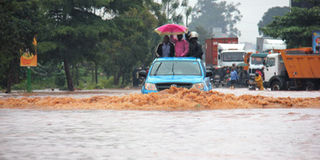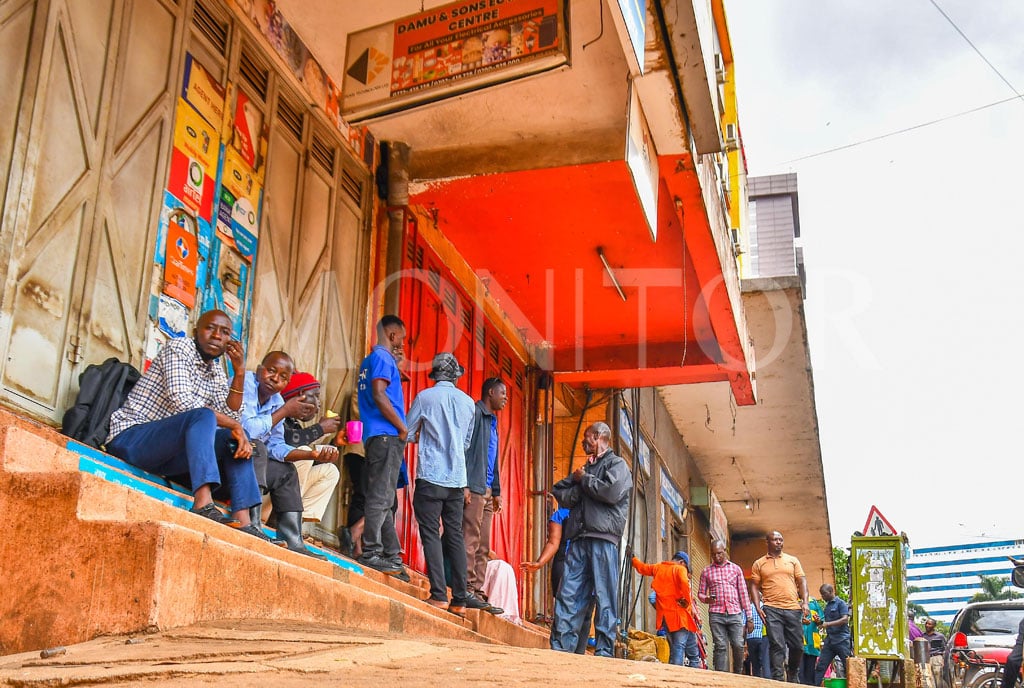Authorities look on as Kinawataka ‘disappears’

Part of Kinawataka wetland in Banda, a Kampala suburb. The wetland has been reclaimed and is now home to some industries and petrol stations. This has caused flooding in neighbouring suburbs like Kyambogo.
PHOTO BYABUBAKER LUBOWA
What you need to know:
Although there is a lot of talk about climate change and the efforts we should take to avert its effects, there seems to be little action to that effect if what is happening to Kinawataka wetland is anything to go by
On some nights, the residents of Kinawataka, a Kampala suburb, hear the heavy groan of tipper trucks drown out the chorus of the in frogs. Powerful headlights pierce through the darkness as trucks dump red soil into this over 180-hectare vast wetland. The morning after, the residents wake up to find a swath of the reed-covered swamp is gone. What was a wetland is now a flat area covered by red soil.
It has been like this—with occasional breaks—for the past three years. The filling happens, stops, then resumes, like it has happened in the past fortnight. It is obvious that those behind this are preparing to turn this wetland into a warehouse. The allure of development on this stretch, however, masks the threat this wetland takeover poses to the environment.
THE WETLAND’S IMPORTANCE
Frank Muramuzi, the executive director of the National Association of Professional Environmentalists, says Kinawataka wetland filters water that drains from the neighbouring Bugolobi, Mbuya and Kireka areas before it goes to Lake Victoria.
“The storm waters come with a lot of filth and silt which is naturally filtered at this swamp,” he says. “Without the swamp, the filth and silt will drain directly into Lake Victoria.”
“This wetland also slows down the flow of water by flooding the plain and eventually reducing siltation in the lake. Without it, the lake is open for silting which may in turn result in higher water levels and flooding,” he says.
This particular wetland also buffers the inner Murchison Bay, which is a source of drinking water for Kampala city. It also helps retain pollutants which ultimately would have hurt Lake Victoria.
Effects of reclamation
As the soil gets dumped into this wetland, the effects are already being felt in the neighbourhood. Just a few kilometres away, in Kyambogo, a slight drizzle sees the main highway flooded.
The reclamation of the swamp has also altered the water course affecting a nearby protected water source. For a community that lacks piped water, this spring has been a life saver. However, residents are now worried about contamination since the spring gets flooded whenever it rains heavily.
When Daily Monitor visited a week ago, heavy machinery was on site with earthmovers busy levelling the swamp. In the neighbourhood, children played as everyone went about their business normally.
It should not be normal. Section 36 of the Environment Act warns against everything that is happening here. It makes it an offence to reclaim or drain a wetland, drill or tunnel in a manner that will adversely affect the wetland, deposit any substance that will have an adverse effect into a wetland or destroy a wetland in a manner likely to have an adverse effect on plant or animal habitat.
Dealing with developers
The environment regulator seems to have his hands tied. Dr Tom Okurut, the executive director of the National Environment Management Authority (Nema), says they are having trouble dealing with developers who have land titles for wetlands.
“The challenge is that most of these titles for these parcels in wetlands were acquired erroneously. Others have just occupied without any documentations whatsoever, like farther along that channel in the Kasokoso area,” says Dr Okurut.
Nema, he explains, is then left with a damage-control role; to ensure that the developments in the wetlands do not adversely affect the drainage of the area.
“That is why we have stopped the reclamation severally before,” he says, before showing Daily Monitor copies of correspondence among his agency, Kampala Capital City Authority (KCCA) and the reported developer identified as Meera Investments. Despite trying to reach Meera for days, all our calls went unanswered.
Part of the correspondence instructs the developer to engage a hydraulic engineer and a surveyor to design a drainage master plan for the area and ensure the upstream drainage is not compromised.
The letter also required those developing that parcel of land to ensure the drainage plan and other developments should consider the upstream and downstream communities and that the said master plan should be submitted to KCCA for approval before anything else is done on the said piece of land.
It was also noted there was urgent need for the developer to provide equipment to widen and dredge the channel passing through the swamp to improve flow of storm water flow as well as demolish a wall which had blocked a section of the channel.
When we contacted KCCA to find out if these guidelines were being adhered to the public health officer referred us to the public relations office which in turn sent us back to NEMA.
The worry though, as Dr Okurut points out, is that continued reclamation of wetlands is a ticking time bomb.
“There are projections that the city may experience catastrophic flooding in 2020s if we continue at this rate,” he says.
If this is the case, who then is responsible for okaying development of wetlands, especially the Kinawataka one? This is a question we put to the chairman of the Uganda Lands Commission, Mr Baguma Isoke. The agency is the caretaker of all public land in the country.
“Have you seen it (the title)?” he asks over the telephone.
When we meet, he says if the title exists, it could have been acquired outside the commission procedures.
“I was the minister of state for environment in 1995 when the environment statute was written. Do you think I could just issue titles? Those are protected areas and we have not issued any titles to those,” says Mr Baguma Isoke.
In his view, the titles could be forgeries or issued by the defunct District Land Board.
The law on wetlands
Section 36 of the Environment Act of 1995 expressly states that No person shall: -
a) Reclaim or drain any wetland;
(b) Erect, construct, place, alter, extend remove or demolish any structure that is fixed in, on, under or over any wetland;
(c) Disturb any wetland by drilling or tunneling in a manner that has or is likely to have an adverse effect on the wetland;
(d) Deposit in, on, or under any wetland any substance in a manner that has or is likely to have an adverse effect on the wetland;
(e) Destroy, damage or disturb any wetland in a manner that has or is likely to have an adverse effect on any plant or animal or its habitat;
WHAT IS ITS FUTURE?
So, is it all lost about Kinawataka? Mr Muramuzi thinks something can be done.
The wetland, he says, can be restored if the law is enforced.
“You just leave it alone and in about two years the wetland will have resumed with most of its flora and fauna,” he says.
But for the already built in areas it would require breaking down structures including paving and carting off the debris that is incongruent with the wetland eco system.
The reclamation path is fraught with challenges. Earlier this year, Information Minister Rose Namayanja announced that the government was instructing the ministry of lands to cancel all titles in wetlands. It is yet to be enforced as the matter is before cabinet.
Meanwhile, in Kinawataka, the trucks continue to dump soil into the wetland. It is fast disappearing.




